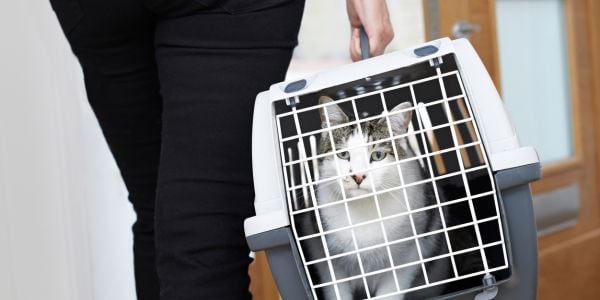
Do you know the biggest reason our feline family members don’t get the veterinary care they need?
Believe it or not, it’s stress — the stress of the entire process – from carrier to car or bus, from waiting room to exam room, and then back home.
And when our cats are stressed, we’re stressed, especially when we feel like we’re forcing them to do this scary thing.
That’s why it’s incredible to see more veterinary clinics committing to lower-stress handling and more cat parents asking what they can do to help their cats feel more secure at the vet. If you’re one of those cat parents, you’ve come to the right place. We’re talking all about low-stress vet visits!
Cats' basic instincts are choice, control, and safety. All of which can be limited when they see their veterinarian.
Why Are Cats So Scared at the Vet?
It actually starts way before they get to the clinic. Many cats get anxious as soon as the carrier comes out of the closet. The vocalizing you hear during the car ride can sound like they’re being tortured. And the real fear kicks in at the veterinary clinic.
But why is it so serious? For that answer, we have to go back in time.
We didn’t technically domesticate cats. Thousands of years ago, we essentially opened the door and let wild cats come into our homes. They decided to stay, and we decided to let them. Over the centuries, we’ve come to co-exist really well. But all those natural instincts wild cats were born with didn’t go away. And we didn’t breed them out. Today’s housecats are mostly unchanged from their wild cat days.

In the wild, cats are prey animals. They’re hunted by other predators, so their primary instinct is to protect themselves. That instinct is still intact with our “domestic” housecats. When we remove their choice and control by confining them in a carrier or forcing them to be handled, for example, they go on high alert.
They didn’t choose to be in that place or do that thing, and they don’t have the option to get out of there if things get dicey. So, the carrier, car, exam room, and being held in place for the exam and procedures go against their most basic instincts — choice, control, and safety.
Even the handling they receive at the vet is going to feel unnatural to them. Most cats aren’t used to having their stomach palpitated or tail lifted. And don’t get a cat started on how we take their temperature! They have no idea it’s for their own good. Of course, they want to resist. They think they’re in danger.
How to Help Your Cat Feel Better About Vet Visits
Can you make your cat feel more comfortable? YES!
Now that you’ve seen things through your cat’s eyes (wearing your cat goggles, as I like to call it), let’s talk about how you can calm those natural instincts in a positive way. You can absolutely do things to help your cat feel safer and more secure with the entire veterinary experience. The earlier you start this work in your cat's life, the easier it will be. But even older cats can learn to calm their fears at the vet.
Preparing Your Cat for Veterinary Handling
One of the reasons vet visits are scary is because the things being done to your cat are foreign. They don’t get their belly palpated and ears examined at home.
You can easily take the newness and fear out of that kind of veterinary handling. When hanging out with your relaxed cat, grab their favorite treat and do the mild version of what your vet might do. Start out super gently, low intensity. Reward with a treat after each touch. As they’re comfortable, you can increase the intensity a bit over multiple sessions. Of course, you’re not actually doing an exam or procedure. You’re just handling your cat in a similar way. Think of it as practice. Here are some things you can practice:
- Touching and looking in their ears
- Feeling around the belly LIGHTLY
- Looking at their teeth
- Lifting their tail
- Handling their legs and paws
- Touching around their eyes
- Rubbing your hand along their back and gently massaging
- Holding your hand over the rib area and rubbing your hand along their ribs
You can even do pretend shots and medicating. Slowly get your cat comfortable with softly touching and gently lifting the skin on their outer thigh (where shots are often given), the lower part of the tail (doesn't work well for small or lean cats, as they don't have as much loose skin in that area), or the flank (the area between the end of the ribs and leg where insulin, if needed, is administered.
Then, touch the scruff with something like a writing pen (cap on). Of course, you’re not causing any discomfort or piercing the skin. It’s just the feeling of the skin being lightly pinched and touched by an instrument (or writing pen, in your case).
For medicating, you can slowly get your cat comfortable using a pill popper (also called a pill gun) or taking water from a dropper or syringe as they would with liquid meds.
Pro Tip for Pilling: Store the dropper or syringe in a Ziploc® with lunchmeat so it has the yummy smell of the meat.
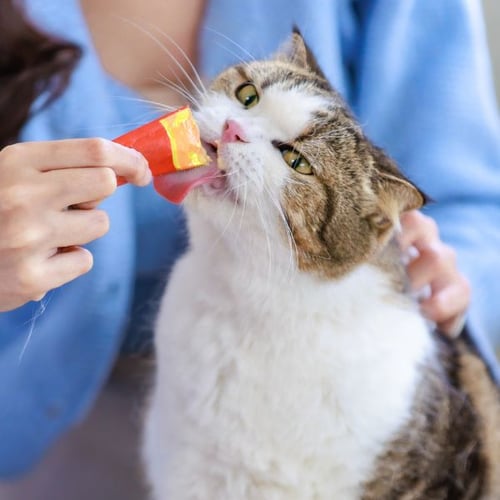
Lickable treats for this kind of training work well. Catit's low-calorie treats with 4.5 or 6.5 calories per tube, depending on the flavor, are a good choice over other brands that are typically higher in calories. With this kind of treating, your cat doesn't have to take time to chew the treat when you're repeating the activity.
Comfort in the Carrier
Your vet visit is going to be rough if your cat panics as soon as the carrier comes out of the closet. So, carrier training is vital to lowering stress at the vet. We’ve got a whole article on how to help your cat get comfortable with their carrier in a positive way. Start by taking the carrier out at least a day or two before or leaving it out all the time.

Comfort in the Car
Continue the process of slowly and positively desensitizing your cat to their carrier by incorporating the car.
Use baby steps to take them from being in the carrier while you open the front door all the way through to going for a ride in the car. Don’t try all of these baby steps in one day. Maybe you just get through one or two in a training session. That will keep the intensity low for your cat.
If they seem relaxed and are enjoying the experience, you can certainly repeat the step a few times in that session to reinforce it. If it was a bit stressful for your cat, you may need to repeat the step for a few days until they're feeling more comfortable. Then, you can move on to the next step.
Session 1: Start with your cat relaxed in their carrier as you open the door to your home. Then, you step outside the door. Head back inside, let your cat out of the carrier, and pile on the rewards.
Session 2: Next time, go from stepping outside to walking to the car and opening the car door. Then, back inside for treats.
Session 3: Then you can get in the car with the engine off. Make sure the car isn't hot, even if it's only for a short time. If possible, slip your cat a couple of treats in the carrier while they’re in the car, and then it’s back inside for treats.
Sessions 4–7: Next, start the engine for a minute. Then, leave the car running for a few minutes. Then, backing out of the driveaway. And finally, take a little drive that doesn’t end in a vet visit. When you get home, let your cat out and throw a little positive reinforcement party with treats, petting, or whatever they love.
Make each step as low-stress and positive as possible. Use your treats and verbal praise to reward your cat’s bravery.
If your cat seems stressed, slow down. Add a few more baby steps between the last step they felt comfortable in and the current step that’s causing stress. They may never feel totally relaxed in the car. But you can remove some of the fear from the process and help them form positive associations with car rides.
You can also control the environment in the car to help your cat relax.
- Warm or cool the car to a comfortable temperature before you bring your cat out.
- Spritz the seat closest to where their carrier will be placed with a calming pheromone spray 10 minutes before putting your cat in the car.
- Turn on some calming cat music. Classical music has been proven to relax kitties. You can even buy music developed specifically to calm cats, on CD, or a portable speaker with pre-loaded music.
Calming Supplements and Medications
There are natural calming supplements that can help kitties relax during stressful situations. In my experience, it’s 50/50 whether they’ll have an impact on a cat or not. Some respond very well. Others have no reaction at all. But they’re certainly worth trying as long as your vet says they’re safe.
Here are some of our veterinary team's favorite calming aids:
-
Zylkene Supplement in capsule form. You can give them orally or open the capsule and sprinkle on your cat's food.
-
VetriScience Composure Max liquid.
Check out treats with benefits in this article.
Calming Medications
Your veterinarian can also recommend medication to relax your cat. This is something you’ll want to test ahead of time so you can confirm the dosage is right. Too high, and your cat may be knocked out. Too low, and they may be able to power through the effects, making it unhelpful for your vet visit.
But remember, this is not a replacement for the stress-reducing tactics above. It’s best used if your cat is still in considerable fear even after you’ve employed other methods. If your cat is on a medication like this, it can be harder for your vet to evaluate them. For example, diagnosing pain or discomfort is difficult if your cat isn’t able to respond naturally.

All of the tactics above can reduce fear and increase confidence in your cat. The better they feel about going to the vet, the more comfortable you’ll feel taking them. That means a higher level of veterinary care for your cat throughout their entire life. It’s worth investing your time in training and desensitization now so you can reap the rewards for years to come.
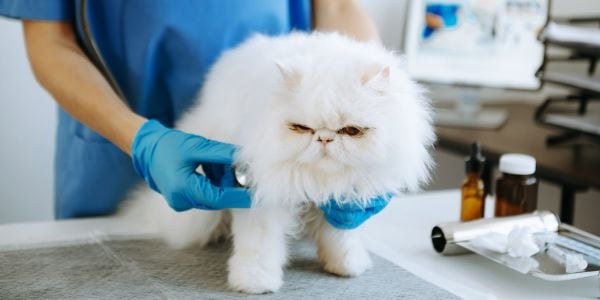
Ask for Your Veterinarian’s Support
You are your cat’s advocate. That goes for their mental health as much as their physical health. You can absolutely ask your vet to support your efforts to reduce stress in the clinic.
Be sure to tell your veterinarian and veterinary nurse your cat's personality and what they are most fearful of. Then, here are some things you can request:
-
Moving you into an exam room right away or asking if you can stay in the car with your cat until the room is ready. You won’t have the stress of a busy, loud lobby or dogs who want to sniff the carrier.
-
A few extra minutes before the veterinarian or technician comes in so you can let your cat relax, step out of the carrier on their own (if they feel ready), investigate, process all the smells, and hopefully eat a few treats if they’re willing.
-
Speaking in a soft voice. Most veterinary staff spend much of the day forced to talk over loud equipment and pets. They may not realize they’ve brought their loud voice into a small room with a scared cat.
-
Taking a moment to introduce themselves to your cat. Instead of jumping right into the exam, hand them a treat, ask them to say “Hi,” and, if your cat is comfortable, give them a little positive attention.
-
Examining your cat in the bottom half of the carrier (if you have a clamshell-style with removable top). This way, your cat doesn’t have to be pulled out of the carrier. Even just doing the exam with your cat covered by their favorite blanket can help. Your vet can uncover just the areas they need, one at a time, while your cat’s head is snuggled under the blanket.
A top-entry carrier is the next best option to a clamshell. You can even bring along a hiding cave with a wide opening so your cat can hide, but you can access them more easily. Here are two caves that would work well: a cat sleeping bag or a peekaboo tunnel that unzips. -
Treating throughout the exam. If your cat is calm enough to eat treats, you or the veterinarian should offer them regularly. Turn that visit into a positive treat party.
- Letting your cat retreat to their carrier as quickly as possible once your veterinarian has completed their exam. Ask your vet if they are finished with your cat first. When they're finished, your cat can head back to the safety of their carrier before you move into the discussion/results part of your visit.
When You Get Home from the Vet
On your way home from the clinic, try not to make a huge fuss over your cat. Just keep things casual. Cover the carrier on three sides so they feel secure, keep music and your voice low, and make your way home.
Once there, your cat may need some time to decompress. If they seem nervous, take the carrier straight into a room they feel comfortable in. Turn the lights down. Have some treats or food and water available. A litter box is a good idea, too. Then, let them out of the carrier, close the door to the room, and let them relax.
This is especially important if you have a busy household or other pets. The smell of the clinic on your cat can actually cause other cats not to recognize them. Vet smells can also be scary. All of this puts the cats who stayed home on high alert and can lead to a fight.
Time in a room alone allows the cat who visited the vet to regain some of their natural scent and shed the vet scent. This also helps keep nosey dogs away too.
You can even rub them with a blanket they sleep on regularly to get that scent back to normal. When you're ready, crack the door. If you're concerned about other cats, have some treats ready for everyone and do a little treat session at the cracked door. If they all seem fine, leave it cracked so your cat can come out when they're ready. If there's any tension or aggression, close the door right away and give them a little more time to decompress and "de-vet stink." Sometimes, it only takes a few minutes. But it can take a couple of days or more, especially if you have nervous cats or one had a really bad experience at the vet. Don't rush it. Better to keep them separated than to rush the process and end up with a big cat fight that changes their relationship. If you do run into trouble, check out the section on Redirected Aggression in our article or reach out to a certified feline training and behavior consultant.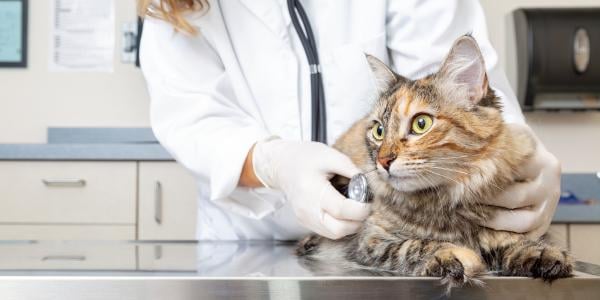
Feline-focused Veterinary Clinics
Another up-and-coming movement in cat care is the feline-only veterinary clinic. They only deal with cats. This means no dogs waiting in the lobby, no barking from the back room, no dog smells to set off your cat’s prey instincts, and the staff are highly tuned into all things “cat.” They only work with cats, so they’ll likely be more familiar with reading and reacting to body language, handling in low-stress ways, and even catching and making tricky diagnoses. I highly recommend a feline-only veterinarian if there’s one in your area.
Even if the entire clinic isn’t feline-only, you can often find veterinarians working within clinics who specialize in cat care.
American Association of Feline Practitioners Cat Friendly Practice
The American Association for Feline Practitioners and the International Society for Feline Medicine created the Cat Friendly Practice program to enhance the feline veterinary environment and experience and reduce stress for you, your cat, and the veterinary staff working with your cat. This extensive training program supports the idea that veterinary care shouldn’t be scary. It shouldn’t put your cat in situations that feel unsafe or unnatural. You can search for Cat Friendly Practices here.
Fear Free Certified Veterinary Clinics
Fear Free is a growing movement in veterinary care. Dr. Marty Becker founded Fear Free in 2016. Using intensive training, the idea is to create a clinic environment and handling procedures that do everything possible to reduce the stress your pet feels from the time you get to the clinic to the time you leave. From quiet rooms with hiding spots, soft music, and pheromone diffusers to a collection of treats given throughout the exam to how the veterinarian and staff physically handle and interact with your cat — it’s all done with the goal of causing no fear. Of course, each clinic and person can vary in their degree of participation. So, it’s still important to observe and advocate for your cat when needed.
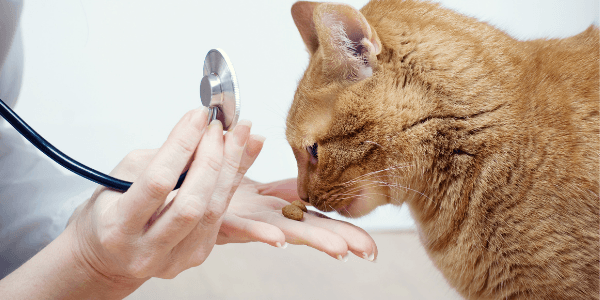
You know your cat better than anyone. Odds are pretty good that your instincts about what they need at any given minute are accurate. Don’t be afraid to ask that those needs be met. The more low-stress vet visits your cat has, the more comfortable they’ll be each and every time.



